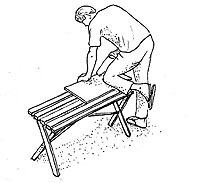Bench for sitting and working

A project on the island of Seram, Indonesia, demonstrated the practical use of table benches as work surfaces as well as for sitting. Multiple benches help in the process of assembling frames. The advantage of using the bench is working off the ground at a comfortable height. An example might be using one's knee to hold a plank being worked on.
Further inspiration was found in a low workbench which was the only useful item found in our barn/workshop at the beginning of our tenure in 1983. Crudely put together by a workman, it served us well for years.
Some children carry their own seats to school. Should such stools not be light weight?
This exemplifies the need for students to be taught to make things for practical use. One such item could be light weight, collapsible, school furniture of appropriate size.
As in many real world situations, floors are not level and so the stool has to be flexible to support its load on all four legs.
How[edit | edit source]
The benches are constructed of small wooden battens interconnected with bits of metal wire. The top is supported by two X-frames, shored by two sticks. The parts are interconnected by strips of rubber which permits easy disassembly. The top is flexible because of the thin battens and the bench is stable to work on because of the braced X-frame legs.
Planned progress[edit | edit source]
The design is light enough to carry and easy to fold. Dimensions of the bench top may be modified based on primary use, larger if mainly used as a work bench and smaller for portability if used as a classroom chair. This stool is useful as school furniture where children need to take them home every day.